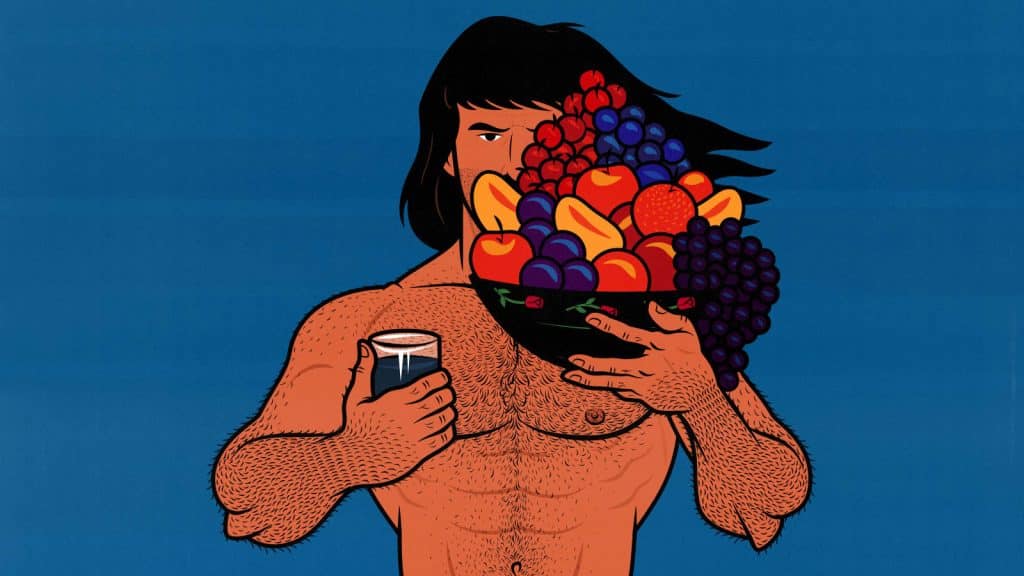
Does Blending Fruits Affect Their Fibre, Nutrients, or Sugar?
I’ve been asked a few times whether it’s healthy to blend fruits into smoothies. Usually, the concern is that blending breaks down the cellular structure of the fruit, releasing more sugar into your bloodstream and spiking your blood sugar. The opposite is true. I’ll explain that in a second.
Another concern is that blending fruits destroys the fibre or nutrients. Blending doesn’t usually destroy anything, and sometimes it releases extra nutrients, but there’s one situation to watch out for. It might be bad to blend bananas with blueberries, kind of.

Does Blending Fruit Increase Blood Sugar?
The main concern with blending fruit is that it will pulverize the cells, releasing sugar into your bloodstream faster and spiking your blood sugar. Blending fruit does pulverize the cells, but it has the opposite effect: it releases more fibre, slowing the digestion of sugar and blunting the blood sugar response (study).
Blending fruits tends to improve our blood sugar response, especially when those fruits have seeds in them (such as berries). For example, one study found that blending up mangos, bananas, passion fruits, raspberries, kiwis, and pineapples reduced their impact on blood sugar compared to eating the fruits whole (study). Another study confirmed the findings (study).
Another study found that common fruit smoothies, such as banana and strawberry, have a glycemic index of under 40, which is quite low (study). Even pure fruit juice, which does spike blood sugar, doesn’t impair glycemic control or insulin sensitivity, meaning that it shouldn’t increase the risk of developing diabetes (meta, meta). I spoke with two diabetes experts about that in this article.
You could argue that fruit juice makes it easier to eat more calories, making it easier to gain fat. However, most research shows that people who drink pure fruit juice aren’t more likely to be overweight(meta, meta), so that isn’t particularly concerning, either.
Does Blending Fruit Destroy Fibre?
Blending fruits does pulverize the fibre, but that’s usually a good thing. It usually releases more soluble fibre, improving your blood lipids and blood sugar (study). If the fruit doesn’t have any fibre that’s difficult to digest, there’s less of a benefit to blending it, but also no harm.
The exception is if you use a juicer instead of a blender. Juicers extract the fruit juice and set the fibre aside. That isn’t bad. You still get many nutrients from the fruit. But it does remove the fibre, so you miss out on a fairly important benefit of eating whole fruits.
Does Blending Fruits Destroy Nutrients?
Blending usually makes it easier to digest the nutrients in fruits. Blending your food is kind of like chewing it very carefully, which is good. For example, blending fruits with seeds in them releases the nutrients in the seeds (study).
One thing to watch out for is oxidation. When you blend fruit, you expose more of it to the air, allowing some of the nutrients to oxidize. Think of an apple or banana turning brown after you cut it open. But you’d need to leave a smoothie out for a long time for the top to start going brown. And even then, you wouldn’t lose all that many nutrients.
Are Smoothies Bad for Digestion?
It’s pretty common for smoothies to cause digestive problems, but that has nothing to do with blending fruits and everything to do with chugging enormous smoothies. I’m a naturally skinny guy, and my specialty is helping naturally skinny people bulk up. It’s common to blend up high-calorie bulking smoothies, and it’s just as common to feel kind of funny afterwards.
If you’re chugging a thousand calories of food blended into a gassy foam, it’s normal to feel burpy and bloated afterward. That’s especially true if you’re using large quantities of ingredients that are hard for some people to digest in large quantities, such as milk, rolled oats, or creatine.
The solution is to make smaller smoothies and/or drink them more slowly. Don’t blend more of a food than you’d normally eat in a meal. I recommend starting with 500 calories and seeing how it goes. If you feel good, bump it up to 600 or 700 calories.
I don’t know of any problem with blending fruits, though. Fruits are a great source of fibre, which is great for digestion. One concern is that blending might destroy some of the insoluble fibre your gut microbiome feeds on, but so far the research doesn’t bear that out.
Is It Bad to Blend Bananas?
Bananas are the most controversial fruit to blend into smoothies. They’re healthy when you eat them whole. Eating 2–4 bananas per day lowers fasting blood glucose, probably because bananas are rich in fibre, polyphenols, and magnesium (study).
The first concern is that it’s bad to blend bananas into smoothies because it increases your blood sugar response. We’ve already covered why that isn’t true. Bananas are good by themselves, and blending them with other fruits further reduces their glycemic index (study, study).
The second concern is that blending bananas into fruit smoothies reduces the amount of healthy flavanols you absorb from the other fruits. This might be true (study). Flavanols are beneficial compounds linked to improved heart health and better brain function. Bananas are rich in an enzyme called polyphenol oxidase (PPO), which breaks down some of those flavanols. (Avocados and apples are also rich in PPO, but they only contain about half as much per gram.)
There’s only one study so far, and flavonols are just one of the many nutrients found in smoothies, but it’s still bad news. For example, let’s say you add blueberries to your smoothie because you want the benefits of anthocyanins, a potent flavanol. If you blend those blueberries with bananas and leave the smoothie out for 30 minutes, you might lose 84% of those anthocyanins.
Here’s how to fix it:
- Eat a varied diet. Smoothies are nutritious in many other ways. If you’re getting flavanols in your other meals, you don’t need to worry about missing out on some of them in your smoothie. For example, green tea, dark chocolate, berries, kale, beans, and onions are all great sources of flavanols.
- Keep your PPOs and flavanols separate. If you’re making a berry smoothie, blend some frozen mango into it instead of using a banana. If you’re making a smoothie with protein powder, peanut butter, and oat smoothie, you may as well use a banana.
- If you’re blending bananas, avocados, or apples into your smoothie, drink it right away. If you drink the smoothie within a few minutes, you’ll get to keep about 70% of the flavanols.
Summary
It isn’t bad to blend fruit. Blended fruit isn’t any less healthy than whole fruit. It doesn’t raise blood sugar, destroy fibre or nutrients, or cause accidental weight gain. Fruit is good for you either way.
The only exception is that blending bananas with flavanol-rich foods (like blueberries) might reduce the benefits of the flavanols. So, if you’re trying to get that particular benefit from blueberries, it might be better not to include a banana.


Muscle-Building Mini-Course via Email
Sign up for our 5-part muscle-building mini-course that covers everything you need to know about:
Here are some related articles